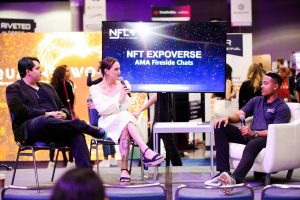The NFT Expoverse in Los Angeles, which ran from July 29 to 31, marked one of the biggest Web3 events in the city since NFTs first took off a little over a year ago. Although the market has crashed since the boom began, optimism for the future of blockchain technology remained high at the event.
More than 200 speakers of all types — from Giovanna Graziosi Casimiro, Metaverse Producer at Decentraland to Bianca Pham, Product Producer with Palm, to Roopal MacDuff of Microsoft — gathered to share one key element of NFTs that’s beginning to take shape: branding. Many businesses are starting to spawn from NFTs as more organizations are establishing themselves on Web3 platforms. There is huge potential for the collections that have weathered this latest crypto crash to become some of the earliest brands in the metaverse.
Leveraging collectibles

Speakers at NFT Expoverse in Los Angeles honed in on the potential to grow a brand by leveraging NFT collections and the metaverse. Image: NFT Expoverse LA
When launching a new NFT collection, the panelists from the “Diving into Collectibles” segment said that it is important for teams to really establish a long-term goal for their brands. That trajectory should encompasses more than just what the individual token can offer, but additionally, objectives for the brand that include exposure and building a fandom.
For many established businesses that operate on Web2 platforms, this fandom is already established, even if those fans might not be fully convinced by the prospect of NFTs. For NFT projects, their entire audience is already integrated into Web3, which paves the way for a more accepting culture around Web3 mechanics.
However, conviction might be easier than it seems. The concept of collecting is not new, and NFTs have not changed that process. Instead, they’ve opened the door for a new set of collectors who find digital collectibles appealing.
Building a brand in the metaverse

As highlighted by panelists at the conference, the virtual environment could be used to expand brand exposure and create a community. Image: NFT Expoverse LA
“NFTs in the Metaverse” was a panel that explained the various ways NFT collections can be used to expand brand exposure within the metaverse. Ideally, this should be done by valuing the technology over immediate profits.
In the metaverse, virtual land will be limited in supply and dependent on the size of the virtual world. While these worlds can continue to expand by adding additional servers, upkeep costs will prevent indefinite expansion from occurring. With this limited space, adjacency will matter for plots like it does in the physical world. Opening up shop in the metaverse on a plot that is next to a well-established Web3 brand such as the Bored Ape Yacht Club will have a positive impact on the value of your plot.
During her panel “Building your Brand in the Metaverse,” Dr. Brunetta Thomas of consultancy Beelogica went on to describe a few key concepts that need to be addressed when developing an NFT collection with the intention of becoming an established project on the blockchain. One of her most important messages was to know your audience like you know yourself. As she explained, the better a team knows an audience the better they can provide what is really being bought: an image. With NFTs, creating a community is incredibly important and having an established image sets the tone for that community.
NFTs as distribution channel
Ultimately, purchasing NFTs within the metaverse which are applicable to an avatar, game, or environment acts as a form of fundraising, allowing content creators full creative control over their products. This allows teams to develop a brand image which is less likely to be skewed by outside influences.
Panelists from “NFTs and Creator Content” explained that the metaverse is enabling new distribution channels that allow branded content to be developed with the community’s involvement. Virtual experiences such as movie theaters, sporting events, and other social interactions will all be able to be bought and sold under a brand name by Web3 teams and with direct input from their community base.
The only caveat to all of this, however, is that Web3 businesses will need to work out models that don’t limit their audiences. While community involvement and input is important for these brands to survive, they need to allow non-NFT holders access to the content. While token-gating works for exclusive memberships, it can hinder products that are meant for the masses. Finding the right balance between the two will be a challenge that every serious NFT team must prepare for if they want their brands to thrive.



